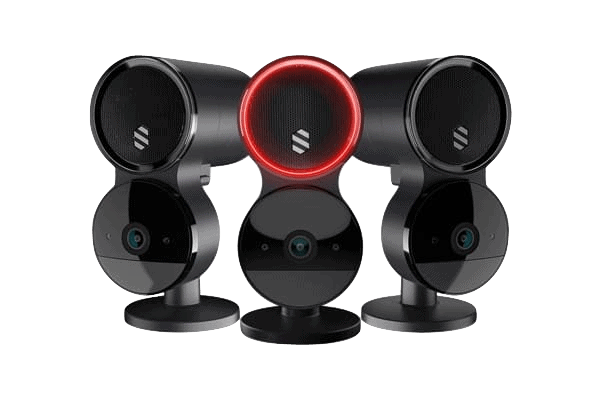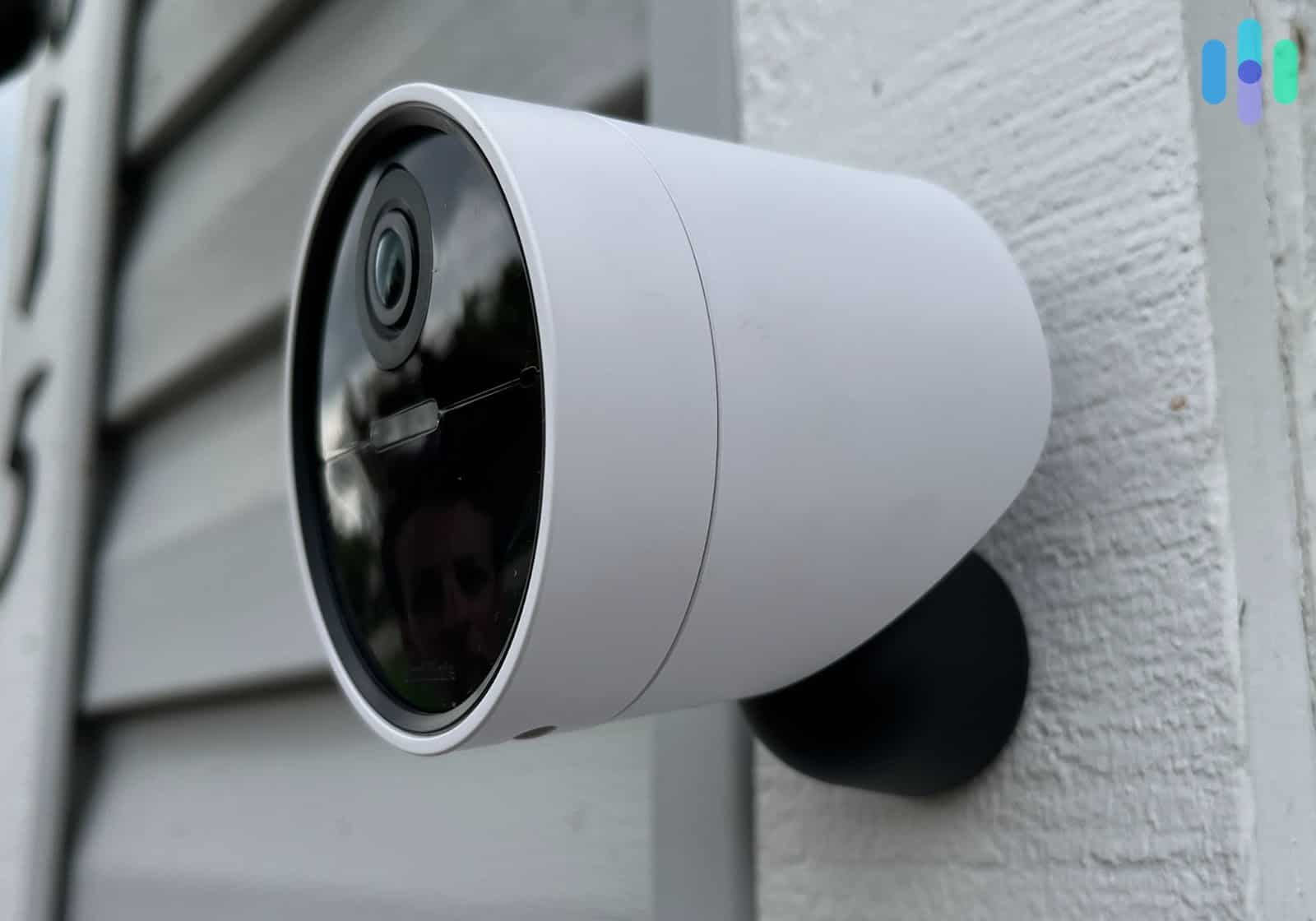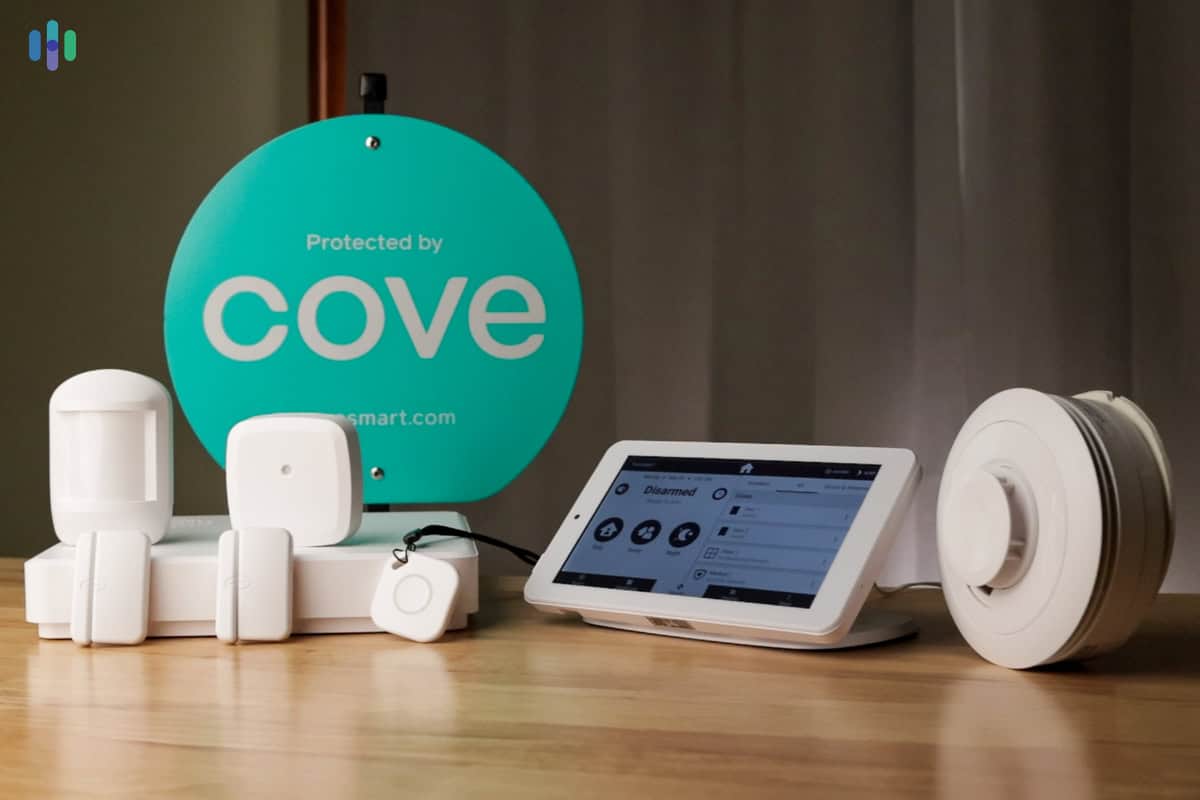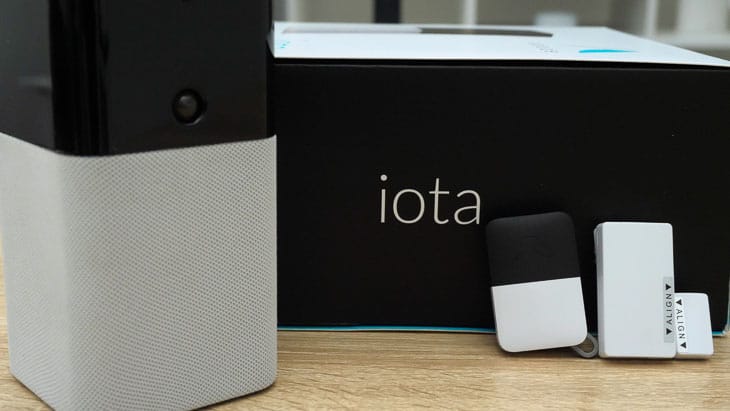The Best DIY Home Security Systems of 2024
SimpliSafe doesn't require professional installation and is effortless to set up with smart devices like Alexa and Google Home.


- No need for professional installers
- Easy to set up voice commands and routines with both Alexa and Google Home
- Pick out the components that are right for your particular living situation

- Affordable equipment and frequent deals
- Systems are fully customizable
- Ships pre-paired sensors and equipment

- Mix of ADT and Google Nest equipment
- High-end security cameras with person and package detection
- Nest Aware subscription included in Essential + Video plan
It used to be that if you wanted a top-notch security system, you’d need to have it installed professionally. But right now, we’re seeing a massive DIY movement. All but one of the best security systems of 2024 offer equipment you can install on your own. Even ADT – one of the old guards of the home security industry that has always required expert installation – now offers a DIY option.
There’s no shortage of good DIY systems, but ‘good’ doesn’t cut it when it comes to your safety and security. You need the best. So we tested and compared eight DIY security systems to find out which ones are the top options. We concluded that SimpliSafe – one of the pioneers of DIY home security – is still the best DIY security system in 2024, especially with its recent innovations in terms of monitoring. We also found five other great picks, namely Cove, ADT, abode, Frontpoint, and Deep Sentinel.
The Best DIY Security Systems, Ranked
- SimpliSafe - Best DIY Installation and Monitoring
- Cove - Most Affordable
- ADT Self Setup - Best Equipment
- abode - Most Flexible Monitoring Options
- Frontpoint - Best Customer Service
- Deep Sentinel - Best Video Monitoring
How to Compare DIY Security Systems
When comparing security systems, whether they’re DIY systems or ones installed by a technician, we always look at the factors most crucial to their job of protecting homes – the equipment they offer and the monitoring options available.
- Equipment: Not all security systems are the same. Some focus more on sensors, while others have a wide selection of security cameras. Choose a security system that offers equipment that meets your security needs.
- Monitoring options: We highly recommend professional monitoring, but not everyone needs this level of protection. For DIY systems, in particular, we like those that offer the flexibility to opt in and out of professional monitoring.
But since we’re talking about DIY systems here, we looked at another crucial factor – the installation experience. DIY installation rarely ever gets done without a single hitch, so we’ll tell you even minor hiccups we experienced during the setup process.
Ready to dig into all our findings? Let’s start!
Side-by-Side Comparison of the Top DIY Security Systems
| System |
SimpliSafe


|
Cove


|
ADT Self Setup


|
abode


|
Frontpoint


|
Deep Sentinel


|
|---|---|---|---|---|---|---|
| Ranking | 1st | 2nd | 3rd | 4th | 5th | 6th |
| Ratings | 9.2/10 | 8.7/10 | 9.0/10 | 8.0/10 | 8.9/10 | 7.9/10 |
| Installation time | 30 minutes | 30 minutes | 30 minutes | 45 minutes | 45 minutes | 1 hour |
| Equipment tested | Sensors, security cameras, video doorbell | Sensors, security cameras, video doorbell | Sensors, security cameras, video doorbell | Sensors, security cameras, video doorbell, home automation | Sensors, security cameras, video doorbell, smart thermostat | Security cameras |
| Monitoring style | DIY or professional | Professional | DIY or professional | DIY or professional | Professional | Professional (Live Guard) |
| Professional monitoring cost (per month) | $21.99 and up | $17.99 and up | $29.99 and up | $22.99 | $49.99 | $100 and up |
| Contract required? | No | No | No | No | Yes (3 years) | Yes (1 year) |
| Read Review | SimpliSafe Review | Cove Review | ADT Self Setup Review | abode Review | Frontpoint Review | Deep Sentinel Review |
What’s The Best DIY Security System For You?
-
1. SimpliSafe - Best DIY Installation and Monitoring
Product Specs
Equipment Costs Packages starting at $280 Monitoring Options Professional and DIY Monthly Monitoring Costs $19.99 per month Contract Lengths Month-to-month Installation Options DIY or professional Smart Platform Integration Alexa and Google Home We credit SimpliSafe for starting the DIY market back in 2006. But what’s really impressive about it is that it stayed true to its original goal of providing one of the best renter-friendly security systems all these years, while also improving to the point that it can go toe-to-toe with the big names in the industry like ADT.
We recently tested a SimpliSafe system (pictured below) and saw that it offers advanced features, reliable equipment, and one of the most comprehensive professional monitoring services available in the market. In fact, we feel confident recommending SimpliSafe as a security system for large homes now; not just apartments and rental units.
In that SimpliSafe test, installation took roughly 15 minutes from unboxing to “All armed!” You read that right! It took us only 15 minutes to install all the equipment you see below. We spent another 15 minutes setting up the doorbell camera though, but that’s a topic for another review.
>> More Details: SimpliSafe Video Doorbell Pro Review
SimpliSafe Equipment
SimpliSafe’s full device lineup SimpliSafe offers equipment ranging from security sensors (entry sensors, motion sensors, glass break sensors, etc.) and safety sensors to security and doorbell cameras. It doesn’t offer home automation devices — that’s one of SimpliSafe’s weaknesses compared to systems like ADT — but it can pair with Alexa and Google Assistant for voice control.1
>> Compare: SimpliSafe vs. ADT
We loved the quality of the equipment. They were lightweight, yet very sturdy. The motion sensor even survived a six-foot drop – not that we recommend dropping the components to test that out. It happened accidentally because the adhesive tape holding it to the wall didn’t hold. More on that later.
Aside from the quality build, SimpliSafe equipment has well-thought-out features, from the base station’s underglow that works as a night light to the built-in battery and cellular backup. The latter kept our system on and connected to the monitoring center during a neighborhood-wide power outage that kept us in the dark for four hours.
Just note that not all SimpliSafe components can work without power. Of the three cameras and one video doorbell, only the SimpliSafe Outdoor Camera Pro can run on batteries. Plus, they all require a working internet connection to record clips and send notifications.
SimpliSafe security cameras Price SimpliCam (indoor camera) $99.99 Smart Alarm (indoor camera) $139.99 SimpliSafe Outdoor Camera $189.99 SimpliSafe Video Doorbell $169.99 >> Further Reading: The Legality of Security Cameras and Video Surveillance
SimpliSafe Monitoring
As part of SimpliSafe’s DIY offering, we were given the option to monitor the system ourselves without added monthly fees. App alerts notified us of potential intrusions, but without live monitoring, it was always our responsibility to check and verify notifications. Thankfully, we had the SimpliCam indoor camera to make checking in a bit easier. See our SimpliCam review for a more detailed look.
SimpliSafe Outdoor Camera For most users, we recommend upgrading to a professional monitoring plan. The two popular options are Standard and Core (formerly Fast Protect), priced at $21.99 and $31.99 per month. Two more options were added recently, called Pro and Pro Plus for $49.99 and $79.99 per month. SimpliSafe’s pricing has become a spectrum due to the addition of those two more expensive options, but we like that it still offers the cheaper plans.
Our favorite among the four plans is Core because of video verification and Live Guard Protection. Video verification allows SimpliSafe monitoring to view live camera feeds to confirm alerts, which can speed up police response.2 Live Guard, on the other hand, lets them use the two-way audio of the Smart Alarm indoor camera to send burglars packing. Those are impressive features for a relatively cheap plan.
The Pro and Pro Plus add one more innovative feature called Active Guard Outdoor Protection, which works similarly to Live Guard but on the SimpliSafe outdoor camera. Pro enables overnight Active Guard protection (8 p.m. to 6 a.m. local time) while Pro Plus enables it 24/7. We don’t think they’re as worth it as Core though, especially since SimpliSafe lacks home automation features that other security systems offer at the same price point.
What We Like
- Set up in 30 minutes
- Indoor and outdoor security camera options
- Cellular and battery backup
- Optional professional monitoring
What We Don’t Like
- Live video monitoring for Smart Alarm indoor camera comes with privacy risks
- Recent monitoring rate increase
- Security cameras don’t record locally
- Security cameras require a separate cloud storage plan or the Fast Protect plan to record
Installing SimpliSafe
We installed SimpliSafe during our lunch break and still had enough time to finish our sandwich. All it took us was 30 minutes. Impressive, right? It’s even more impressive that half of that time was spent setting up the only hardwired SimpliSafe product, the Video Doorbell Pro. Without it, we would have been done in 15 minutes or so.
SimpliSafe is hands-down the easiest to install. Was it hitch-free? No. We found out that the battery-powered outdoor camera needed to be charged before installation, so we charged it overnight and set it up the next day. But that was the only setback we faced.
Here’s the whole process:
- We set up the base station by plugging it in, and then we turned on the keypad by removing the battery tab. They connected to each other right away.
- We downloaded the app and signed in. We also linked the base station to our app and connected it to Wi-Fi.
- Using the app, we paired sensors individually with the base station. Most of them were battery-powered, so we simply removed their battery tabs to turn them on.
- We placed the sensors. They each came with a peel-and-stick adhesive backing; very convenient.
- We plugged in the indoor camera, scanned a QR code using the app, and connected it to Wi-Fi.
- The next day, after charging overnight, we followed the same steps to connect the outdoor camera to Wi-Fi. We then mounted it out on the porch.
A quick note on the installation, though: The peel-and-stick adhesive tape that comes with sensors are great if you want a fast and easy install, but we don’t recommend it for permanent installation. It tends to lose grip over time, especially when attached to concrete walls. It’s the reason one of our motion sensors crashed, and it’s not just a SimpliSafe problem. That’s true for all DIY security systems.
Whenever possible, anchor your sensors to walls using screws. Most SimpliSafe sensors come with a mounting template.
>> Read More: The Best Battery-Powered Security Cameras
-
2. Cove - Most Affordable
Product Specs
Equipment Costs Must customize package Monitoring Options Professional Monthly Monitoring Costs Starting at $17.99 per month Contract Lengths No contract required Installation Options DIY Smart Platform Integration Alexa and Google Home 
When we say DIY systems, we mean security systems you can install on your own. It doesn’t always mean you can self-monitor the system like with SimpliSafe. Such was the case with Cove; you’re required to pay a monthly fee for monitoring, but you still save on installation costs.
That’s not the only way you can save, though. Cove is our top budget-focused pick. Our comprehensive Cove system cost us no more than $300, including cameras. And on top of that, we received a generous 65-percent discount just by signing up for the Cove Plus monitoring plan. With the discount, our door and window sensors cost only $7.50 a pop.
We didn’t just get lucky, either. For most of the year, Cove offers discounts between 40- to 60-percent. The 65-percent off deal comes about three to four times a year, especially around special days like Black Friday, Fourth of July, Christmas, and New Year. So if you can, time your purchase to coincide with holidays.
>> Related: Affordable but Top-Quality Security Systems
Cove Equipment
Cove Security System Cove let us pick from a wide range of security components. They weren’t as high-quality as the sensors from ADT Self Setup and SimpliSafe. In fact, they felt plastic-y and a little on the lightweight side. We were careful not to accidentally drop them during installation, but fortunately, every piece worked right out of the box.
We got ourselves a bunch of security and safety sensors (they have smoke alarms, unlike abode), plus a couple of security cameras. The cameras were from the brand Eufy. They offered great specs, like 2K video quality, but just like the sensors, they didn’t feel as durable as our top security camera options, such as the ones from Lorex. (See our Lorex review.) In any case, they were affordable. We got one outdoor camera for free, and an indoor camera for $49.99 with discounts applied.
>> Learn More: Eufy 2K Camera Review
Cove Monitoring
Cove gave us two monitoring options, both of which were for professional monitoring. The system doesn’t work as a self-monitored alarm.
Feature Basic Plus $5 per month equipment reward No Yes 24-hour battery backup Yes Yes 24 / 7 professional monitoring Yes Yes Alexa and Google Home integration No Yes Cellular backup Yes Yes Environmental monitoring Yes Yes Hourly automated system check Yes Yes InstaText Yes Yes Length of equipment warranty 1 Year Lifetime LiveAssist Yes Yes Smartphone control No Yes Smash and grab protection Yes Yes TripleTouch communications Yes Yes Monthly cost $17.99 $27.99 That’s a long list of features for plans that cost less than $30 per month, but to summarize, the Plus plan adds access to security camera livestreaming and recording, as well as priority customer support. It also upgrades the equipment warranty from one year to lifetime, meaning, for as long as you’re signed up to the Plus plan. In our opinion, that’s well worth the $10 increase, which is why it’s what we went with.
What We Like
- Affordable equipment and frequent deals
- Systems are fully customizable
- Ships pre-paired sensors and equipment
- Professional monitoring with security camera support for less than $30 per month
What We Don’t Like
- Some pieces of equipment don’t seem durable
- No self-monitoring option
- Limited security camera options
- Security cameras are accessed via a third-party app
Cove Security System and Cameras Installing Cove
Remember how we said that anyone can set up Cove? It’s true, because Cove ships their security systems ready to work. So when we opened the box, we simply turned on the Nintendo Switch-looking touch screen keypad and started pulling the battery tab out of each sensor. We didn’t even need to use our phones until it was time to connect the system to our account.
As a little side note: Despite Cove’s pricing, it was the only DIY option we tested with a touch screen keypad. That’s great, because the others required the use of a smartphone app. Although smartphone control is a convenient way to control the system when you’re out of the house, most people still prefer having a keypad of sorts for when they’re home.
Now, back to the setup. Once the system was fully installed, we followed the keypad’s instructions for testing the system. It was quick and easy — we activated the monitoring subscription, did a test run with customer support, and that was it! It was simple, user-friendly, and straightforward, exactly what you want from a DIY system.
>> Also See: The Best Security Systems With Apps
There was one downside stemming from the fact that Cove’s cameras are made by Eufy. It’s that we needed both the Cove app and the Eufy app to manage our security system. We armed and accessed our sensors via the former, but used the latter to playback recordings and watch live video streams from the cameras. It wasn’t a deal-breaker, but it was inconvenient having to switch back and forth between apps.
Pro Tip: Our next pick, ADT Self Setup, also uses security cameras from a different manufacturer. But unlike Cove, ADT integrated them into the same app used to manage the security system.
-
3. ADT Self Setup - Best Equipment
Product Specs
Equipment Costs Starting at $195 Monitoring Options Professional or DIY Monthly Monitoring Costs Starting at $24.99 Contract Lengths Monthly Installation Options DIY Smart Platform Integrations Google Nest Cams, Google Assistant, Alexa ADT is best known for its professionally installed and monitored security system. You can see it in action in our ADT review. Not too long ago, however, it introduced its own version of a DIY security system, which is a combination of equipment from two home security powerhouses: ADT and Google Nest.
The aptly named ADT Self Setup includes sensors from ADT, as well as high-end security cameras and a video doorbell from Google Nest. That, plus ADT’s world-class monitoring service, makes ADT Self Setup worthy of a spot on this list.
>> Read More: Google Nest Doorbell (Battery) Review
ADT Self Setup Equipment
ADT Self Setup Window Sensor The quality of ADT Self Setup equipment is great, but we were underwhelmed by the number of available options. The Self Setup system doesn’t offer as many types of sensors or devices as the full ADT system. It certainly doesn’t offer as many device options as SimpliSafe, abode, and Frontpoint, either.
We got ourselves a five-piece kit with two door sensors, a motion sensor, a flood sensor, and a smoke alarm. And of course, we still have the Google Nest Cam (Battery) we reviewed and the Nest Hub Max we tested, which we were able to pair as well.
ADT Self Setup Monitoring
Monitoring costs the same whether you have ADT Self Setup or the professionally installed ADT system. The advantages with ADT Self Setup is that you can also self-monitor and you won’t need to sign a contract if you buy yourself an ADT monitoring plan.
ADT Self Setup doesn’t offer any less features either. Your system will be monitored by any of the 12 ADT monitoring centers equipped with backup generators, communication lines, and servers. You will also access ADT’s SMART Monitoring platform, which speeds up the monitoring response time by using text-based alerts. Here’s how the plans are priced:
ADT Self Setup professional monitoring Essential Essential + Video Cost per month $29.99 $34.99 Contract Monthly Monthly Professional monitoring Yes Yes Home Automation No Yes SMART Monitoring Yes Yes Nest Aware No No Video verification No No >> Related: The Best No-Contract Security Systems
What We Like
- Mix of ADT and Google Nest equipment
- High-end security cameras with person and package detection
- Nest Aware subscription included in Essential + Video plan
- Affordable professional monitoring
What We Don’t Like
- Limited sensor options
- No included keypad (costs an extra $89.99)
- Bulky hub
- Not as smart home-friendly as other options
Installing ADT Self Setup
Right off the bat, we noticed the hub’s bulky form. It stood about six inches tall and had a width and depth of about four inches. The rectangular shape didn’t help at all. First, we figured out a place to put it. It ended up on our entertainment rack, next to our router.
Google Nest Cam on house ADT Self Setup didn’t include a keypad (just like abode), so the entire setup was done through the app. We connected the hub to our phone via Bluetooth and introduced it to our Wi-Fi via the ADT+ app. We also paired all five sensors through the app. This part of the process took less than 10 minutes.
After that, we set up the cameras and the smart display. They were previously set up from when we reviewed them, but if it’s your first time setting them up, allot about five minutes for each camera and device. In our case, though, we just logged into our Google Nest account on the ADT+ app to pair the Nest devices.
Note: The hub only connects to 2.4 GHz Wi-Fi channels. If you have a dual-band router, make sure you connect your phone to the 2.4 GHz band before pairing the hub. If you’re connected to the 5 GHz channel, it simply won’t connect.
-
4. abode - Most Flexible Monitoring Options
Product Specs
Equipment Costs Packages starting at $140 Monitoring Options Professional and DIY Monthly Monitoring Costs $24.99 per month Contract Lengths Month-to-month or yearly Installation Options DIY or professional Smart Platform Integration Alexa, Google Home, and Apple HomeKit abode is similar to SimpliSafe in many aspects, but it has a deeper reach into home automation, making it a particularly great choice for those who want a high-tech security system.
To capitalize on the smart home aspect, abode works with a number of third-party devices. That means you’re not limited to abode equipment. You can pair Z-Wave, Zigbee, and even HomeKit products. Of course, that means a more complex setup process, but even though our home is well-equipped with home automation devices, it still took us less than an hour to set up abode.
>> Related: The Best Smart Home Security Systems
abode Equipment
The Abode Iota security system. abode security systems are anchored by a hub, for which abode offers three options: Smart Security Hub, abode Security Hub, and iota All-in-One Hub.
Smart Security Hub abode Security Hub iota All-in-One Hub No built-in camera No built-in camera Built-in camera Ethernet-only Ethernet or Wi-Fi Ethernet or Wi-Fi Loud siren Loud siren Loud siren Alexa, Google Assistant, HomeKit, Z-Wave, Zigbee Alexa and Google Assistant Alexa, Google Assistant, HomeKit, Z-Wave, Zigbee No built-in motion sensor No built-in motion sensor Built-in motion sensor We decided on the most advanced option, the iota All-in-One, because the hub itself contains a built-in 1080p security camera, a siren, a motion sensor, battery backup, and a cellular chip. From there, we picked from the available abode packages priced between $279.99 and $399.99. The packages contain door and window sensors, acoustic sensors (aka glass-break sensors), and motion sensors. We also added add-ons like an indoor camera, smart bulbs, and smart plugs.
We noticed that abode doesn’t offer smoke alarms. What it has is a listener that listens for the beeping sound of your smoke alarm when it goes off. You still need your own smoke alarms, but the listener makes sure you’re alerted when they sound, even if they’re just traditional smoke alarms (not internet-connected). Other than that, abode’s equipment is fairly well-rounded.
abode Monitoring
abode has the most flexible monitoring options we’ve ever seen. It has free self-monitoring, premium self-monitoring ($6.99 per month), and professional monitoring ($22.99 per month).
We initially went with the premium self-monitoring option, called Standard, which gave us 10-day video history, person detection for our cameras, access to the CUE home automation engine (similar to IFTTT), and priority customer support.
>> Learn More: The Best Security Systems With IFTTT Support
abode Camera After one month, however, we felt that we needed more, so we upgraded to professional monitoring. The main reason, besides that it offered live monitoring, was the ability to access cellular backup. Although we connected the hub via an Ethernet cable (which is more reliable than Wi-Fi), we know our internet connection. We know that it cuts out occasionally. Cellular backup made sure abode was always online. That alone made the $22.99 we paid abode worth it.
>> Learn More: The Best Security Systems With Cellular Backup
What We Like
- Choice between different types of hubs
- Affordable security cameras (as low as $34.99)
- Quick and easy DIY installation
- Free and premium monitoring plans
What We Don’t Like
- Lots of missing features from free monitoring option (e.g., home automation)
- Internet-reliant without professional monitoring
- No cellular backup even for premium self-monitoring plan
- No smoke alarms or carbon monoxide detectors
Installing abode
abode didn’t give us much headache with the install. It was fairly standard; we set up the hub, connected it to the app, and then paired the sensors.
Our one gripe is that the iota hub had to be connected to our router via an Ethernet cable. It supports Wi-Fi, but it needed an Ethernet connection for the setup. That could turn out to be a minor inconvenience for those who are gunning for a wireless install. Anyway, once the hub and abode app were paired, we entered our Wi-Fi SSID and password on the app to set up the Wi-Fi connection. After that, the iota hub let us disconnect the Ethernet cable. (FYI: You set up the abode Security Hub the same way, but the Smart Security Hub is Ethernet-only.)
As for the sensors and other components, we didn’t have much trouble pairing them. The entry sensors came pre-paired with the hub, so after pulling out their battery tabs, they paired instantly. For the other sensors and devices, we had to initiate the pairing process via the abode app. Each sensor took approximately one minute to pair. All in all, we set everything up in less than 45 minutes.
-
5. Frontpoint - Best Customer Service
Product Specs
Equipment Costs Starting at $99 Monitoring Options Professional only Monthly Monitoring Costs Starting at $49.99 Contract Lengths 1-36 months Installation Options DIY Smart Platform Integration Alexa and Google Home Customer service rarely gets talked about, but with DIY systems, good customer service is critical. You’re doing all the installation work, so you’ll want to choose a company willing to help every step of the way. That’s where Frontpoint excels, in our opinion. It offers great equipment and a decent monitoring service, but the customer service is simply top-notch. We had our own encounter with customer support during setup, which we’ll share below, and all we can say is that we were satisfied with their response.
>> Further Reading: Frontpoint FAQs
Frontpoint Equipment
Frontpoint System We built a custom Frontpoint system from scratch, starting with the basic kit that costs $129. It included a hub, a motion sensor, and an entryway sensor — pretty bare bones — but we expanded it by adding more sensors, security cameras, and even a smart lock and thermostat. All in all, we spent over $500 on equipment, but if that’s too much to pay at once, you can choose to finance it and pay over 36 months following a credit check.
Take note that Frontpoint occasionally offers discounts. You can sometimes get the basic kit for as low as $79, and add-on equipment sometimes has markdowns of up to 60 percent. We say take advantage of those deals if possible; Frontpoint isn’t the cheapest option around.
>> Alternative Options: The Best Security Systems Without Credit Checks
Frontpoint Monitoring
The buying process for Frontpoint was all online, just like with SimpliSafe and abode. But there’s one tiny difference: Frontpoint requires professional monitoring. Unlike our two other picks which let us add or remove professional monitoring, Frontpoint’s monitoring service was automatically added to our cart. In fact, we had to fill in our details (name, monitored address, emergency contact numbers, etc.) before we could checkout.
The monitoring subscription didn’t start until we activated the system, though, after which we paid $49.99 per month. We also signed a three-year lock-in contract.
Those — Frontpoint’s pricing and the contract — were nonnegotiable. Frontpoint offers only one monitoring option that covers everything from cellular backup and monitoring to cloud video storage and home automation. It bode well for us because we bought a complete Frontpoint system, but that universal pricing is the reason we don’t recommend it for basic home security. The price is the same whether you have a couple of sensors or a dozen of them. Self-monitoring is also not an option.
What We Like
- Customer support available until 11 p.m. (EST)
- 30-day money-back guarantee and three-year equipment warranty
- Semi-affordable equipment
- Functional app
What We Don’t Like
- Universal monitoring pricing for all systems
- Three-year contract
- Limited smart home options
- May require a credit check
Installing Frontpoint
Our Frontpoint installation didn’t go as smoothly as our SimpliSafe and abode installations. We got the package late afternoon and immediately got to setting it up. We started with the hub. We plugged it into a wall outlet and then opened the Frontpoint app on our iPhone, which guided us through setting up the hub and pairing it with the keypad. So far, so good.
Next, we connected the sensors and the cameras. The sensors had a ‘pair’ button that we pressed and held to make them discoverable. On the other hand, since the cameras needed a Wi-Fi connection, we set them up via the app. It was a standard security camera installation.
Frontpoint Indoor Camera One door sensor, however, refused to connect even after several tries, so we skipped it to finish the rest. After about 30 minutes, we circled back to it and spent another 15 minutes or so trying to connect it. It was past seven o’clock when we decided to give Frontpoint a call. We were surprised we actually got through. Most alarm companies don’t have customer support after normal office hours.
The agent we spoke with helped us troubleshoot the door sensor and after a few minutes, he concluded that it must be broken. Frustrating, yes, but things like that happen. The silver lining though, was that he immediately put in a request for a replacement, which was delivered to us two days later. That’s top-notch service, in our opinion.
-
6. Deep Sentinel - Best Video Monitoring
Product Specs
Equipment Costs Starting at $399 Monitoring Options Professional and DIY Monthly Monitoring Costs Starting at $60 Contract Lengths 1-12 months Installation Options DIY Smart Platform Integration None Deep Sentinel isn’t your typical security system. It doesn’t offer sensors, but rather, it relies solely on AI-powered cameras to detect intrusions. What sets it apart from the likes of Arlo and Lorex, which also offer AI-powered cameras, is that it offers live video monitoring. This is similar to SimpliSafe’s Live Monitoring for Smart Alarm, which we discussed earlier.
Of course, having strangers monitor your camera can be a cause for privacy concerns. To fix that, Deep Sentinel has a thorough vetting process for its monitoring agents. On top of that, Deep Sentinel requires that its cameras be placed outdoors — never indoors. That way, they can stop burglars before they get in while also preserving your privacy.3
>> Further Reading: Do Security Cameras Deter Crime?
Deep Sentinel Equipment
Deep Sentinel Hub and Battery Deep Sentinel offers only one type of equipment, which is — you guessed it! — security cameras. They are battery-powered and they come with a removable battery. A charging station that doubles as a hub and provides local video storage is also included.
The specs of the camera are decent. It’s comparable to the Arlo Pro 3 we reviewed — with a weatherproof casing, three-month battery life, a 130-degree viewing angle, two-way talk, and AI person detection — but with slightly lower video resolution. Deep Sentinel is 1080p, while Arlo Pro 3 is 2K.
Deep Sentinel Monitoring
The most interesting aspect of Deep Sentinel is its monitoring. First, let’s cover the cost. As we expected, Deep Sentinel’s pricing is higher than others on this list. It costs a whopping $100 per month for one camera, plus $50 per month for each additional camera. That’s $200 per month for our three-camera system. Deep Sentinel isn’t cheap, and here’s why.
When the camera detects a possible intruder, it starts streaming to the LiveSentinel monitoring center. A trained guard there will check the footage to verify it, and if it’s a real threat, they’ll use the camera’s two-way audio to engage the intruder. The goal is to make the intruder go away before they get inside your home. If that doesn’t work, Deep Sentinel will call the police to submit a verified dispatch request. That real-human engagement is what customers pay for.
Is it worth the over $100 monthly fee? Maybe for some, but it’s clearly not for everybody.
>> Alternative Options: The Best Outdoor Security Cameras
What We Like
- Live video monitoring and response
- AI-powered detection and human verification
- Local and cloud recording included
- Easy DIY installation
What We Don’t Like
- Expensive hardware ($499 for one camera and hub)
- Perimeter security only
- Potential privacy issues
- Short battery life (2 to 3 months)
Deep Sentinel Cameras Installing Deep Sentinel
The Deep Sentinel equipment looked intimidating to install, but the setup process was actually quite easy, especially since the cameras were wireless and battery-powered. We first set up the hub, which connected to our router via Wi-Fi. Once it was on, we inserted the large, cylindrical batteries into the cameras. They booted up and paired with the hub in seconds. Deep Sentinel pre-paired the cameras before shipping.
What ate up most of our time was installing the cameras. It helped that they were wireless with a 100-foot wireless range, but we still had to experiment with the positioning to make sure they had a clear view of the most important areas — our front door, the pathway to our house, and our backyard. All in all, we spent about 45 minutes mounting the cameras, in addition to the 15 minutes we spent unboxing them.
FYI: Deep Sentinel also offers Power over Ethernet (PoE) cameras, which are more reliable than their wireless cameras. However, these PoE cameras require professional installation.
Why DIY? The Pros of DIY Security
Having a security system dramatically improves your home’s safety and protection from crime, but professionally installed security systems can be quite pricey. Not only is the equipment cost higher than most DIY systems, but there’s also the installation cost, which usually reaches over $100. In contrast, DIY security systems are not only more affordable equipment-wise, but there are also no installation or activation fees. DIY security systems are practical.
>> More Information: How Much Is a Security System?
On top of that, they’re convenient. You don’t have to wait around for a technician to show up. If you’ve had a security system professionally installed before, you know they don’t usually give you a specific time for your appointment. They give you a window — sometimes two hours, sometimes an entire afternoon. With a DIY system, you can do it in your spare time (even in the evening, like we did with Frontpoint).
Here are some other pros of DIY security systems:
- Easy to move: Because they’re wireless, DIY security systems are easy to move to a different address. In most cases, you simply box them up and reinstall them in your new home. You can’t do that with most hardwired systems.
- Renter-friendly: Again, because they’re wireless, you likely won’t lose your security deposit after installing a DIY security system. Most sensors attach to walls with adhesive, and very few components — if any — require drilling.
- Cheaper or optional professional monitoring: This doesn’t apply to all DIY security systems, but most of them don’t require professional monitoring. You can self-monitor, which is usually free. And those that offer professional monitoring, like SimpliSafe and Cove, offer lower rates than professionally installed systems like ADT.
>> Read More: DIY Installation vs. Professional Installation
Things to Consider: The Cons of DIY Security
All those benefits of DIY security systems also come with disadvantages. Otherwise, professionally installed systems would be phased out. Here are some points to consider before fully deciding to buy a DIY security system.
- Prone to incorrect installation: We’re not perfect. Even technicians whose bread and butter is installing security systems make mistakes; this applies doubly so to those of us who have no special training. What’s more, it’s your home’s security on the line here.
- Warranties are limited: In the same vein, since you’re doing the installation work, DIY systems often have limited warranties, and repairs stemming from incorrect installation will be your responsibility. In contrast, professionally installed systems often come with lengthy warranties and guarantees, like ADT’s six-month money-back guarantee.4
- Limited equipment options: In their bid to make installation as easy as possible, most DIY systems limit the type of equipment they offer. ADT Self Setup, for example, doesn’t offer wired video doorbells, so you’re stuck with the battery-powered option that requires recharging from time to time.
>> See Also: The Best Video Doorbells of 2024
What To Look For in a DIY Security System
We can see from those examples that the biggest downside of DIY security systems is the fact that you’ll do the installation yourself, which can be prone to mishaps. However, if you do that part right, DIY security systems are actually great. So here’s our solution: Look for a DIY security system that will give you the best chance of installing the system correctly.

Here’s what you should look for:
- Wireless: The key ingredient is being wireless. A hardwired security system is too much to handle for someone without training. And besides, most wired systems require professional setup.
- User-friendly app: As we saw earlier, most DIY systems rely on an app for setup, monitoring, and control. That’s an advantage, unless you end up with an app that hardly ever works, so choose a system with a working and user-friendly companion app.
- Customer service: And last but not least, don’t discount the importance of customer service. You’ll do the setup yourself, but you shouldn’t feel like you’re on your own. After all, who’s better to help you than the company from which the equipment came? Instruction materials and troubleshooting guides also fall under customer service.
Outside of those factors, remember that you should be getting a security system that meets your needs — even with the limited components of most DIY systems. Generally, these are the types of equipment you’ll want to find:
- Security sensors: These are door sensors, motion sensors, glass-break sensors, garage tilt sensors, and others that you can use to detect possible break-ins.
- Safety sensors: These sensors are designed to detect other types of home dangers, like fire and gas leaks. There are also safety sensors designed to detect non-life-threatening incidents like flooding or burst pipes.
- Security cameras: Security cameras can widen the scope of your monitoring ability. They give you visual access to your home when you’re not there. Plus, you can use them to communicate with family members or unwelcome guests.
- Video doorbells: Similar to security cameras, video doorbells provide visual access and two-way communication, but specifically for your front door.
- Smart home devices: These are optional, but home automation can help make your home even safer. For example, lights that turn on when a door or window is opened can scare away burglars.
>> More Options: The Best Security Cameras of 2024
Recap
DIY security systems are fun. Installing and testing them is one of our favorite parts of our job. As a homeowner, however, choosing a DIY security system is a serious matter. It’s one that requires careful consideration. We know that, which is why we urge you to take your pick from our list of the best DIY systems. These are systems we tested ourselves, and they are also some of the best security systems on the market today.
Of course, you’re free to make your own decision. If none of the options we recommended above seem like a good fit, take a look at our home security guide, which discusses how to best pick a security system for your specific setup, wants, and needs.
Frequently Asked Questions
While you think more about DIY home security, we’ll answer the questions we get the most.
-
What is the best “do it yourself” security system?
The best “do it yourself” or DIY home security system is SimpliSafe. With SimpliSafe, we had DIY installation and self-monitoring in addition to 24/7 professional monitoring.
-
What is the best home security system without a monthly fee?
The best home security system without a monthly fee is also SimpliSafe. However, if you don’t pay for a plan, you won’t get notifications, remote control or smart home integrations. Basically, it’ll become a local alarm system only.
-
Which is better, SimpliSafe or Ring?
SimpliSafe is better than Ring, although both are ranked in the top 10 of our list of the best home security systems. It has better iOS and Android apps, easier DIY installation and better customer support.
-
What are the top five home security systems?
After thoroughly testing dozens of systems, we can confidently say that the top five home security systems are ADT, SimpliSafe, Vivint, Alder, and Cove.
SimpliSafe. (2024). Does SimpliSafe® Integrate With Other Smart Home Devices?
support.simplisafe.com/articles/using-your-system/does-simplisafe-integrate-with-other-smart-home-devices/634492857c2ab96af9f1d6f6National Monitoring Center. (2024). VIDEO VERIFICATION
nmccentral.com/video-verification/Deep Sentinel. (2024). See How Deep Sentinel Works
deepsentinel.com/how-deep-sentinel-works/ADT. (2024). Residential Security – Terms and Conditions
adt.com/about-adt/legal/residential-terms-and-conditions





















